Newsletter
Current
Previous
|
September 2011
|
|
|
|
|
PHENOLOGY, not a word for everyday conversation, but something increasingly of interest to those who study trends in climate change. The Woodland Trust in the Nature's Calendar website has a definition: "Phenology is the study of the times of recurring natural phenomena, especially in relation to climate. It is recording when you heard the first cuckoo or saw the blackthorn blossom. This can then be compared with other records... Over the past 40 years phenology has provided biologists with clear evidence that spring is arriving earlier." Among their significant findings, trees are coming into leaf earlier and some migrant birds are arriving earlier.
Comparison over a couple of years would be as good as useless, but data collected over many years reveals a more definite pattern. Some individuals have been doing this for years. Robert Marsham, known as the founding father of modern phenological recording, was a wealthy landowner who kept systematic records of "Indications of spring" on his estate in Norfolk from 1736. Consistent records of the same events or "phenophases" were maintained by generations of the same family over long periods of time, eventually ending with the death of Mary Marsham in 1958. The data shows significant variation in dates which broadly correspond with warm and cold years. However, between 1850 and 1950 a long-term trend of gradual climate warming is observable, and during this same period the Marsham record of oak leafing dates tended to become earlier. If you want to become involved in phenology, go to www.naturescalendar.org.uk.
One possible way to combat global warming is to install solar panels and use the energy of the sun to create electric power. See the very informative article on investing in solar panels on page 3.
Exciting news of an eagle closely associated with Earley is on page 4.
|
|
Get to know your Earley:
|
Remains of an old green lane?
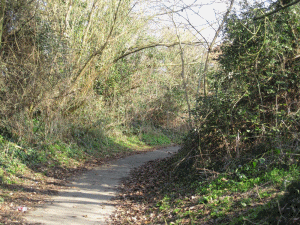
|
1881 OS map, Crocker's Farm, site of Hillside school
|
|
|
|
|
A peek into the world of local mammals
Squirrels and foxes are a frequent sight in the Maiden Erlegh nature reserve, but how many other mammals live around the lake and the adjoining woods and meadows? To gain a glimpse into the secretive world of hedgehogs, rats, mice, voles, shrews and the like, the Earley Environmental Group arranged for humane mammal traps to be set on Friday, 8 July and invited members to see what was caught the following morning.
Maryanne Thomas, an experienced specialist in mammals, led the session. Early on the Friday evening she, and members Grahame, Ricki and Richard, set 18 traps in the lower meadow, downhill from Instow Road towards the lake. Sites were selected around the margins, along the banks and hedgerows, with some in the middle of the flower meadow, to represent a variety of habitats suitable for several species of animal. Each trap was baited with corn (for mice and voles), insect 'casters' (for the carnivorous shrew) and apple (as a source of moisture). They were then placed carefully in the thick vegetation; their locations discreetly marked with an identifying yellow tag on a branch or stalk nearby and recorded on a GPS device.
At 9.00 am on the Saturday, 22 members and friends of the Group assembled in Instow Road. As they were gathering a fox made a brief appearance, before turning tail and melting away. Foxes weren't the objective of the day, but a welcome sighting on a mammal morning none-the-less. The intended targets were various types of mice, voles (bank and field voles), and shrews. Maryanne explained the process. To save trampling the wild flowers, only she and Richard would check the traps and retrieve the undisturbed ones. Any that were closed would be brought back to the path, opened, emptied, and then Maryanne would identify the creature and hold it up for examination.
|
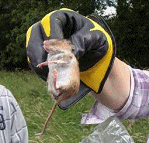
| Voles and shrews decided not to co-operate but a charming female wood mouse did.
This was a very brief demonstration in mammal trapping for the benefit of the EEG members, and Maryanne explained that far more traps would normally have to be set in an area the size of the Reserve meadow.
(This is an abridged version of a write-up of the event by Edwin Trout)
|
|
|
FACTS ABOUT THE WOOD MOUSE
Grows to about 10cm long and weigh 30 grams or so full grown.
Traditionally roams fields, hedgerows, forests and grass lands where it can find plenty of food.
Tends to have a short life in the wild as so many different creatures prey on it, with an average age between 6 and 12 months.
Can reproduce quite frequently with the gestation period around 25 days, and can reproduce several times per year.
Nocturnal animals with superb hearing and vision (hence the large eyes and ears).
A vital source of food for other larger nocturnal hunters
|
|
|
Solar panels have started appearing on lots of roofs in Earley - what are they, and will they work for you?
|
Since April 2010 the government-backed 'Feed In Tariff' or 'Clean Energy Cash-back' scheme has made electricity-generating 'photovoltaic' (PV) panels appear economically attractive for many people with southerly-facing roofs. The government's aim is to kick-start the industry and bring prices down, so from April 2012 the subsidies for new installations will fall.
|
| |
PV panels turn sunlight into electric current which is converted to mains frequency and voltage by an 'inverter', a box of electronics usually smaller than a desktop PC, often located in the loft. Any power not used in the home is 'exported' to the mains supply network. Maximum output is achieved in direct summer sunlight and depends on the slope of the roof and the direction it faces. They generate much less in winter and on dull days, and not at night or in really poor light. It is important that shadows (e.g. from chimneypots) do not fall on the panels.
Ian Porter of Instow Road, had an array of 17 panels fitted last November and said that he 'is very pleased with them' and thinks that this year they will give him 8-9% return even though his roof faces west. We had our 12 panels installed in March and it was exciting to see our meter running backwards - but our electricity supplier was keen to install a new meter! We had scaffolding up for a week but the actual installation of the panels and wiring changes were done in a day.
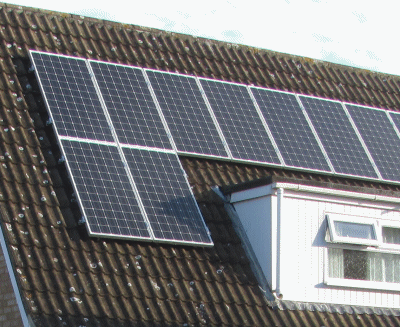 For typical domestic systems installed before the end of March 2012 homeowners will receive 43.3 pence (index linked) per unit generated and 3.1 pence per unit for electricity exported to the main supply (assumed to be half of generated power unless an export meter is installed). Any power used in the home saves around 12 pence per unit. This is expected to give between 5% and 8% return on investment. For typical domestic systems installed before the end of March 2012 homeowners will receive 43.3 pence (index linked) per unit generated and 3.1 pence per unit for electricity exported to the main supply (assumed to be half of generated power unless an export meter is installed). Any power used in the home saves around 12 pence per unit. This is expected to give between 5% and 8% return on investment.
Five or six panels, with an area of about 7 square meters, provide about 1 kW peak output. Over a year they would be expected to generate 700 to 800 kWh worth £350 to £400 to the homeowner. A typical domestic installation will be 10 to 20 panels rated at between 2 kW and 4 kW peak output. The cost is around £3,500 to £5,000 per kW peak output.
Payment comes from the electricity supplier, and is effectively paid by their customers, so increasing the cost of electricity.
Electricity from PV panels is expected to have a carbon footprint of about 58 grams per unit compared to a typical UK figure of around 450 grams per unit and coal-fired power at about 800. As well as reducing carbon emissions there should be benefits to air quality and energy security.
The Feed-in-Tariff regime has made PV panels advantageous for individuals who can afford to invest in them but at present they are an expensive way for society to make carbon savings. We hope that the government is right to think that PV prices will fall rapidly as the industry grows.
John Booth
References:
Energy Saving Trust FiT web-pages
Friends of the Earth booklet - Feed In Tariffs and the renewable heat incentive - your questions answered.
'Sustainable Energy Without the Hot Air' http://www.withouthotair.com
Parliamentary Office of Science and Technology report on carbon footprints: October 2006
Reading Energy Pioneers - self-help group - but spring 2011 purchasing round has now closed.
Contact:
John and Anne Booth, 27 Instow Road, Earley, Reading. booths@clara.net 0118 9868260
|

|
|
Earley's Eagle flies again
If your DIY experience includes the use of an 8ftx 4ft sheet of building board, just imagine drawing the life-sized outline of a flying eagle on it and puzzling that the wing-tips might not fit on. That is the White-tailed Eagle, often referred to as "the flying barn door".
So what has that to do with Earley? The Old-English name for that bird was the Erne and its woodland, or Lea, gave rise to the name of Earley (see newsletter banner). Archaeological records show that these birds were still native to the Thames Valley in Saxon times. Sadly the species was hunted to extinction in Britain by the 19th Century, but has more recently been very successfully reintroduced into the West of Scotland.
Very occasionally an immature bird (which has a dark tail), usually from the Scandinavian population, arrives to winter in Southern England. Last winter one appeared in Sussex in December and then re-located to the Hordle area of the New Forest in January. In early March it moved northwards to Old Basing, where it also attracted a lot of attention. I failed to see it on the 17th, but the forecast for Saturday, 19th was propitious for a migrant: bright and sunny, with air moving north-east on the back of Friday's wet front. I suspected that I had one more chance...

Mary and I were out early and soon in situ at a farm to the east of Old Basing, where we joined a number of other birders. As the frosty start gave way to sun, first a Sparrowhawk, then a pair of Kites, then several Buzzards took to the warming air. It was eventually 11 a.m. before the massive shape of the eagle swooped low along the valley. For a time it perched in a tree, harried by the smaller raptors, but eventually it took off and gained height on a thermal. Buzzards seemed to appear from all over the landscape and, at one time, the gigantic bird was in a cloud of nine of them, with two Red Kites for good measure. Slowly and inexorably, the bird rose on the mid-morning thermal to be lost from sight, drifting towards the north-east on what appeared to be a definitive farewell to Hampshire. But vaguely north-east from there is Earley...
A few articles ago, I suggested an "eyes to the skies" approach. Did anyone see a barn door pass? If so it would have been a historic day.
Ray Reedman
Ray further wrote that the same bird has spent the time since it left this area up on the east coast and was reported in Lincolnshire.
|
|
|
A less ordinary sighting in Earley
|

|
A beautiful hummingbird hawk-moth, photographed in Instow Road, June 3rd.
Their wings beat at an incredible 70 - 80 beats per second, which allows them to 'hover' in the same way real hummingbirds do.
Photo by Anne Booth
Click on the picture for a larger one
|
|
|
|
Year of the Bat 2011 - 2012
Claire Andrews of Berkshire and South Buckinghamshire Bat Group lead a bat walk on May 25th for the Friends of Maiden Earley Nature Reserve. The evening started well with a talk attended by about 25 to 30 people, Rosie and another pipistrelle. Several members of the bat group were present including James, Katie, Rose-Anne and Bob, Steve and Glyn.
The walk then started quietly with no bats picked up initially but soon we started picking up our first pipistrelle bats, with some good views of them feeding in the open areas beside the lake. We picked up both common pipistrelle and soprano pipistrelle bats here.
We then made our way to the north side of the lake, and excitement mounted when we caught a fleeting glimpse of a noctule, which quickly receded into the distance; we need not have worried as within a few minutes we were treated to some excellent views of noctules tearing up and down the lake with plenty of feeding 'buzzes' as they went.
As we moved further down the lake we started picking up Daubenton's (as it was now dark enough for these bats to emerge), and had good views of these bats hunting just over the surface of the water; especially good views were achieved from the bridge at the end of the lake.
Use was made of the EEG bat detector bought with funding from the Earley Charity.
|
|
|
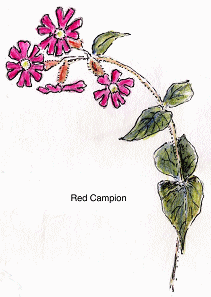
|
Some local wild flowers
Illustrations by Patricia, an EEG member

|
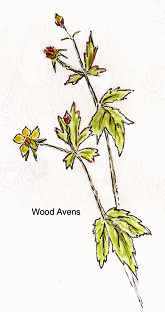
|
A few, small facts on the wild flowers growing in Earley's wildflower meadows, woods or roadsides.
Alkanet, possibly green alkanet, the latter being found in hedges, roadsides and shady places. Red dye can be extracted from the roots. Not a welcome plant in the garden, being difficult to uproot.
Wood avens: once said to protect against charms and spells, its fresh leaves contain high quantities of vitamin C.
Red campion (Silene dioica): Abundant in most area of Britain. Incidentally, its name is from Silenus, the drunken, merry god of Greek mythology. Each plant has flowers of one sex only.
There are several wildflower meadows attracting many insects in Earley, including Maiden Erlegh Local Nature Reserve, a real picture in spring and summer.
|
|
|
NEWS FROM BEYOND EARLEY
The good news: Is this Britain's most 'artful' bird?
Peregrine falcons are returning to our cities in increasing numbers. Misty and Houdini, two 11-year-old falcons, are fast becoming the Tate Modern's most regular visitors. There are now nesting sites in Manchester's Arndale centre and at Durham and Chichester Cathedrals.
The bad news:
Deforestation in Brazil's Amazon accelerated in June, with more than 300 square kilometres destroyed, a 17 percent increase over the previous month, government researchers said Tuesday. (The Independent 7.8.2011)
|
EARLEY NEWS and WILDLIFE SIGHTINGS
Spotted in Earley Gardens in July:
Margaret
Birds visiting:
Blackbird, blue tit, chaffinch, collared dove, goldfinch, great tit, robin, woodpigeon, dunnock, jay, long tailed tit, garden warbler, white throat. Tawny owl heard nearby, green woodpecker and gt. spotted woodpecker observed to and fro over garden to Highwood, Canada geese low over towards South Lake.
Butterflies observed:
Green-veined white, holly blue, large white, painted lady (buddleia), red admiral (buddleia).
Also spotted in the garden:
Common frog, pond skaters, emperor dragonfly, 7 spot ladybird, 24 spot ladybird, bombus terrestris, bombus lapidarius, lacewing
Gillian
Birds visiting:
Many of the above but in addition magpie, wren and starling. The green woodpecker was seen on front lawn feeding two young.
Butterflies observed:
Holly blue, red admiral, small white, speckled wood, gate keeper.
Also spotted in the garden:
Grey squirrel, bat, frog.
|
LOCAL FORTHCOMING EVENTS 2011
|
September: | Wednesday 14th, 7.30pm, a talk by Lesley Dunlop on Geoconservation and Geoconservation sites in Berkshire in the Function Room, Maiden Place Community Centre
| |
October: | Wednesday 5th, 7.30pm a talk by Phil Baker on "The urban fox: a welcome presence?" in the Function Room, Maiden Place Community Centre
| |
November: | Wednesday 16th, 7.30pm a talk by Martin Haslam on Lichens in Function Room, Maiden Place Community Centre, followed by:
| |
| Sunday 20th , 2.00pm, Interpretation Centre, Maiden Erlegh Reserve, Instow Road, Martin Haslam leading a walk to look for lichens, weather permitting. If the weather is bad then we will bring samples of lichens on trees, stones, etc, to look at with Martin.
| |
December: |
Monday 19th, 7.30-10pm, EEG Christmas Social in Interpretation Centre, Maiden Erlegh Nature Reserve, Interpretation Centre
|
|
|
|
|
Bits and pieces
EASI (Earley Adopt-a-Street Initiative). Volunteers needed. Help keep your street clear of litter. Everything provided. Phone Brian Hackett on 0118 986 1115 or email ask.mera@btinternet.com.
Can you offer active help to the Group? If so, phone 0118 962 0004 or go to contacts. We would welcome more member involvement. If you have no expertise and would like to get involved, you may be able to give practical help. Perhaps help with distributing the newsletter hard copies, or maybe you have graphic design skills (for occasional posters, leaflets), computer skills, any other skills to offer. Do your bit for the environment.
Join the EEG Yahoo Group and post your sightings and messages. You’ll find a link to Yahoo on our website.
EEG Committee Members can be found on www.earleyenvironmentalgroup.co.uk under Contacts, or phone 0118 962 0004
For Wildlife Survey Forms, go to the website or phone Earley Town Council 0118 986 8995
Comments or contributions to the newsletter to: the Editor or 2 Reeds Avenue, Earley, RG6 5SR. We would welcome short contributions from members to the newsletter.
If you know anyone who would like to join EEG, membership forms are available from Earley Town Council, 0118 986 8995, on the website under Downloads , or send an e-mail to the Membership Secretary. Please inform Liz if you intend to change e-mail or address at 50 Kenton Rd, Earley RG6 7LG, or send her an e-mail.
|
SUPPORT YOUR LOCAL SHOPS
The True Food Co-op, Silverdale Centre :There is now a True Food Co-op operating in Earley, their most successful market. Their mission is to take low cost organic food out to the people, bypassing the supermarkets which charge a lot for organics They hold markets at the Silverdale Centre on Fridays, 5 to 8. 15 pm. They have a website giving dates www.truefood.coop
Pet Fayre 9 Maiden Lane Centre Lower Earley : A small independent shop, with bird feeders of all kinds, a variety of bird feed, large bags of which the shop is willing to deliver locally, or pick it up in your car from the back of the shop, tel 0118 9266512, e-mail sales@petfayre-reading.co.uk or go on the comprehensive website www.petfayre-reading.co.uk
|
|
Thanks to ORACLE Corporation for reproducing our newsletter on recycled paper. Oracle is the world's second largest software company, situated at Thames Valley Business Park in Earley. Oracle UK adheres to the ISO14001 Environment Standard which confirms Oracle has considered and acted upon its environmental impact. As part of Oracle’s corporate social responsibility they support a number of local groups, including us. They have given us valuable support in reproducing the hard copies of our newsletter in colour, as well as printing posters and membership leaflets for us to distribute to libraries, schools etc. |
|